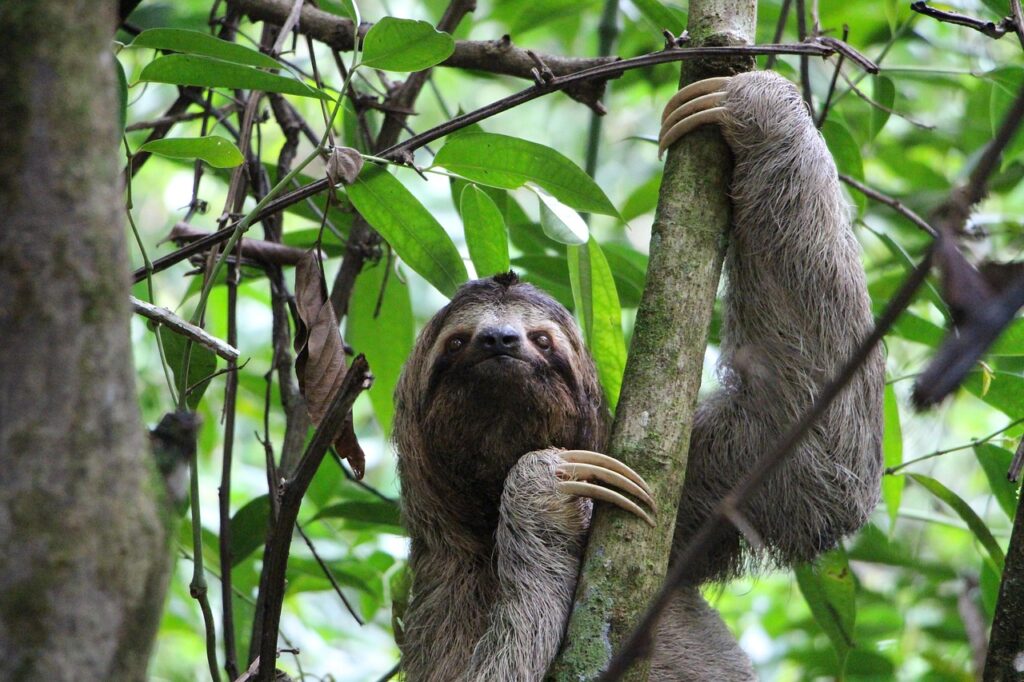Costa Rica

Bradypus Variegatus
Everything moves in Costa Rica. The branches above you. The ground beneath. The air itself. Blink, and something flashes past — green, gold, or winged. A toucan lands. A monkey leaps. A frog calls out like a digital echo from somewhere in the dark. Here, nature doesn’t wait politely for your attention. It surrounds you. Closes in. It’s loud, layered, and wildly alive — not in pieces, but all at once.
This is a country that packs five percent of the world’s species into a sliver of land. A hummingbird’s heart beats over a thousand times a minute here — and so does the rhythm of the forest. Every inch is claimed by something: vines, insects, lichen, ants, flowers, fungi. It’s not a wilderness in the sense of emptiness. It’s the opposite. It’s full to the edges and overflows.
You don’t explore Costa Rica. It envelops you.
Some Places Speak in Roars
Costa Rica is not subtle. It growls, sings, chirps, and drips. Sloths don’t just sleep — they float in their stillness. Frogs don’t just hide — they glow neon under moonlight. Even the ants here build highways. You might see a jaguar. You probably won’t. But the idea of it changes how you walk. How you breathe. That’s the magic — you don’t have to see everything. You just have to feel that it’s there.
More Than Biodiversity — It’s Philosophy
Costa Rica doesn’t just protect nature. It prioritizes it. Over 25% of the country is protected land. National parks, reserves, biological corridors. And this isn’t done quietly — it’s proudly woven into identity. “Pura Vida” isn’t just a phrase. It’s a way of being in a place where life is respected, preserved, and celebrated.
Creatures That Live in Color
If You Come Here, Be Ready
For sweat. For mud. For beauty you don’t have time to process before the next moment arrives. Costa Rica isn’t a destination. It’s an immersion. A sensory overload. A lesson in how many shapes life can take when it’s left to thrive.
You don’t conquer the wild here. You witness it — and if you’re quiet, humble, and curious, it might just let you in.
This is a country that packs five percent of the world’s species into a sliver of land. A hummingbird’s heart beats over a thousand times a minute here — and so does the rhythm of the forest. Every inch is claimed by something: vines, insects, lichen, ants, flowers, fungi. It’s not a wilderness in the sense of emptiness. It’s the opposite. It’s full to the edges and overflows.
You don’t explore Costa Rica. It envelops you.
- Osa Peninsula: The most biologically intense place on Earth, some say. Scarlet macaws, jaguars, tapirs, poison dart frogs, and spider monkeys — all under the same canopy, all talking at once.
- Monteverde Cloud Forest: A dream suspended in mist. Resplendent quetzals glide between moss-draped branches. Howler monkeys groan like thunder in the fog. You don’t walk through Monteverde. You drift through it.
- Tortuguero: Accessible only by boat. A flooded world of canals and hidden lagoons, where caimans lurk, manatees drift, and sea turtles rise from the sea to bury eggs under moonlight.
- Corcovado & Piedras Blancas: Not places for a quick visit. These are the slow jungles — wet, dense, and buzzing with life that hasn’t read any rulebook about staying hidden.
- Dry Forests of Guanacaste: A surprise to most. Parched, golden, loud with parrots. Home to anteaters, iguanas, coatis, and dancing butterflies on cracked earth trails.
Some Places Speak in Roars
Costa Rica is not subtle. It growls, sings, chirps, and drips. Sloths don’t just sleep — they float in their stillness. Frogs don’t just hide — they glow neon under moonlight. Even the ants here build highways. You might see a jaguar. You probably won’t. But the idea of it changes how you walk. How you breathe. That’s the magic — you don’t have to see everything. You just have to feel that it’s there.
More Than Biodiversity — It’s Philosophy
Costa Rica doesn’t just protect nature. It prioritizes it. Over 25% of the country is protected land. National parks, reserves, biological corridors. And this isn’t done quietly — it’s proudly woven into identity. “Pura Vida” isn’t just a phrase. It’s a way of being in a place where life is respected, preserved, and celebrated.
Creatures That Live in Color
- Resplendent Quetzal: Iridescent, mythical. Seen in highland forests, where it floats through the trees like a falling jewel.
- Sloth (Two- and Three-Toed): Iconic and unapologetically slow — and yet somehow always in the right place.
- Glass Frog: Transparent skin. Beating heart visible. Lives where most people don’t look long enough.
- Jaguar: Almost invisible. Almost. But still here. Still watching. The forest knows where it walks.
- Leafcutter Ant: The most organized creatures in the jungle — cutting, carrying, building, farming, surviving. A full society on the forest floor.
If You Come Here, Be Ready
For sweat. For mud. For beauty you don’t have time to process before the next moment arrives. Costa Rica isn’t a destination. It’s an immersion. A sensory overload. A lesson in how many shapes life can take when it’s left to thrive.
You don’t conquer the wild here. You witness it — and if you’re quiet, humble, and curious, it might just let you in.
